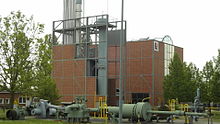German Chemistry Museum Merseburg
 German Chemistry Museum Merseburg, entrance area with fan wheel (2014) |
|
| Data | |
|---|---|
| place |
Merseburg |
| opening | 1993 |
| Website | |
| ISIL | DE-MUS-719417 |
The German Chemistry Museum Merseburg (" dchm ") is a museum founded in 1993 to present the development of the chemical industry in the region of Central Germany on the basis of original chemical equipment and plants.
The museum occupies an area of 36,255 square meters on the Merseburg campus . The German Chemistry Museum in Merseburg is unique in Europe and world-class.
history
The museum was founded in the course of German reunification after the dismantling of many industrial and chemical plants in Central Germany out of the motivation to save chemical apparatuses and plants that were important in terms of technology history and to combine them as exhibits into a comprehensive collection.
The association Sachzeugen der chemical Industrie e. V. (SCI) was founded in 1993 in order to be able to carry out and finance a corresponding museum work (chairman of the board: Klaus Krug and since 2010 Thomas Martin , professor for process engineering at the University of Merseburg).
The museum, which was set up and run by the “SCI” association, works closely with the Merseburg University of Applied Sciences , which was founded on the Merseburg campus in 1992 and has taken over the role of host from the former “Carl Schorlemmer” Technical University in Leuna-Merseburg .
The Hands-On Chemistry project was launched in 1997 in order to impart chemical knowledge experimentally to schoolchildren and entire classes in school laboratories. In 2003, the areas of the student projects were expanded and the concept further developed in the direction of chemistry that you can touch and understand technology . By the end of 2005, around 33,000 students had already taken part in a total of 45 series of practicals (500 individual experiments).
exhibition
The collection consists of approx. 5,000 objects, of which more than 300 can be viewed in a technology park. Important sources of this material evidence from the chemical industry were the neighboring large companies in the central German chemical triangle Halle / Merseburg, Leipzig / Böhlen, Dessau / Bitterfeld, in particular the Leuna works in Leuna and the Buna works in Schkopau .
The most important exhibits of the museum are its ammonia synthesis chamber located in the center of the museum premises and the associated large circulation pump , both from the early years 1916/1917 of the large-scale ammonia synthesis using the Haber-Bosch process . The chemist Fritz Haber was awarded a Nobel Prize in 1919 and the industrialist Carl Bosch in 1931 . These exhibits are housed in two large brick buildings. The functional circulation pump for the high pressure process can be admired in a special exhibition room.
The museum exhibits a large number of different types of pumps and compressors as well as a wide range of other equipment from the chemical industry in the entrance area and on the entire museum grounds .
A small viewing hill overlooks the southern part of the museum, which houses the following chemical plants:
- Fan wheel of the chemical plant construction company Grimma .
- Chemical train
- Scraper cooler for dewaxing petroleum fractions,
- a mixing plant for chemical substances,
- historical plant for the synthesis of zeolites ,
- Riveting processes explained using examples from industry,
- Systems for mechanical material separation ,
- Reactors for the production of polyvinyl chloride and for the electrolysis of calcium carbide ,
- Plant for high pressure polymerization of ethylene ,
- Distillation plant ,
- a rubber belt machine and the rubber test laboratory from a former facility of the Buna-Werke in Schkopau ,
- Production series for chlor-alkali electrolysis with the electrolysis cells: diaphragm cell, membrane cell and amalgam cell.
In this area, a train with three wagons typical for chemical operations and an FLC-type steam storage locomotive from the Leuna works has been set up from LKM production . Previously, after being taken out of service, this machine was exhibited first at the Merseburg train station and then at the Merseburg Aviation and Technology Museum. The battery- powered locomotive of the type LEW EL 16 also exhibited there comes from army stocks, but vehicles of this type were also from industrial companies and the like. a. the Leuna works .
Type of presentation
The museum objects are arranged thematically in subject groups. The individual objects are described on assigned information boards and explained in detail so that visitors can choose to visit them. In addition, a visitor service also offers guided tours with a historical classification and demonstrations (e.g. functional large circulation pump for the high-pressure technology presented).
swell
- ↑ German Chemistry Museum. Retrieved October 2, 2013 .
- ↑ Brief conception - German Chemistry Museum Merseburg; Page 5 (PDF; 357 kB), accessed on October 2, 2013.
- ↑ Brief conception - German Chemistry Museum Merseburg; Page 3 (PDF; 357 kB), accessed on October 2, 2013.
- ↑ Brief conception - German Chemistry Museum Merseburg; Page 7 (PDF; 357 kB), accessed on October 2, 2013.
- ↑ Site plan and tour - Deutsches Chemie Museum Merseburg , accessed on October 2, 2013.


